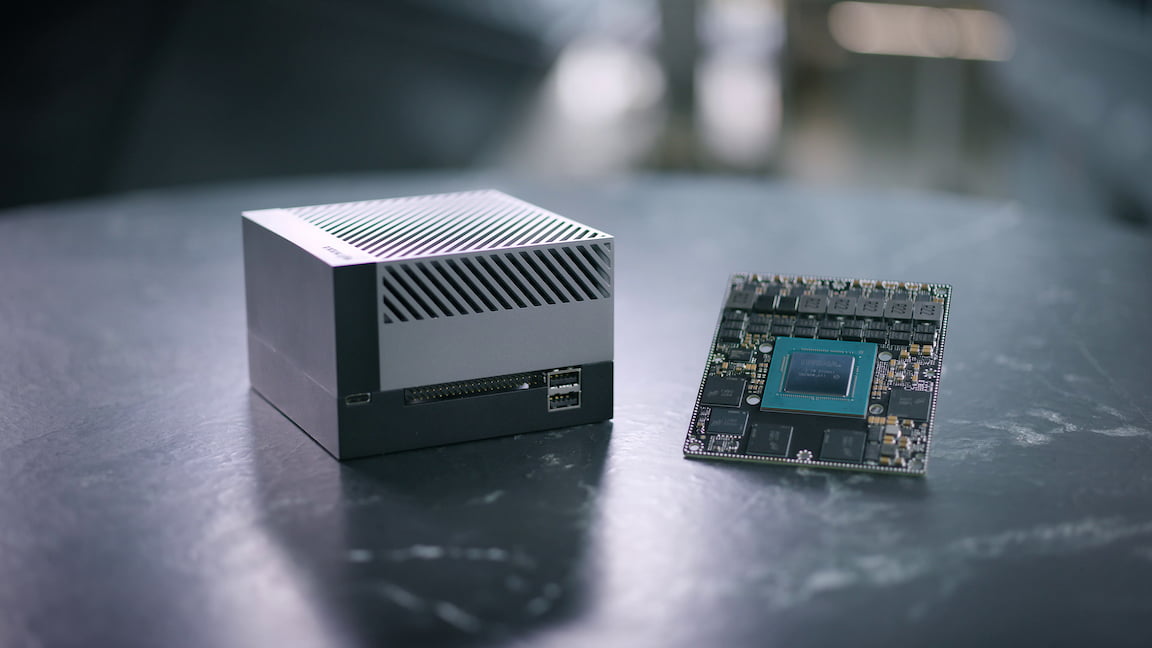At the latest GTC, NVIDIA announced that they will begin shipping the Jetson AGX Orin in early 2022.

Introduction
The Jetson AGX Orin is the next generation AGX form factor Jetson. The AGX Orin module has the same footprint as the Jetson AGX Xavier, using the same 699 pin connector. Here’s some quick specs for the AGX Orin Developer Kit:
Tech Specs
We can see from the specs some of the reasons that NVIDIA claims a 6-7X performance improvement over the earlier AGX Xavier. The Orin uses the new NVIDIA Ampere architecture with 2048 CUDA cores and 64 Tensor Cores. The AGX Xavier has 512 Volta Architecture CUDA cores with the same number of Tensor Cores.
By comparison the Orin CPU complex consists of 12 ARM Cortex A78AE v8.2 64 bit CPUs, grouped in fours. The Xavier has 8 ARM Cortex A72s. For the Orin, the memory is faster with 32GB of 256-bit LPDDR5 main memory versus the older LPDDR4 of the Xavier.
The Orin has 15W, 30W and 50W power modes.
How Do We Keep Getting Even More Computing Power?
The CEO of NVIDIA, Jensen Huang, famously stated that “Moore’s law is dead”. Kinda, sorta. If you look at the past history of the Jetson, we know that the Tegra X1 chips (currently in the Jetson Nano) have ~2 billion transistors. The Xavier Tegra chips have ~7 billion. The new Orin Tegra chips have ~17 billion! With just about every generation of Jetson you get 2x the number of transistors of its predecessor.
How does that happen? The key is the manufacturing process. the Tegra X1 uses a 20 nanometer (nm) process, the Xavier a 12nm process and the Orin a 8nm process. The process is the main factor on how many transistors you can fit in a given space on the chip die. The smaller the process, the smaller the transistor. Thus more transistors in a given amount of space.
That explains how you get more transistors, but you can imagine that there’s a physical limit. 5nm is now becoming available. However, as you keep getting smaller you will eventually reach the point where the electrons won’t be able to be contained. After all, they can only put up with so much. They want to be free!

Another interesting aspect of having more transistors is how to take advantage of them in the compute stream. Modern computer hardware architecture is a really interesting area. If you haven’t studied it or haven’t visited the area in a while, it’s well worth taking some time and listen to some talks and read up on the subject.
Sofware
The big news on the software front for the Jetson AGX Orin is that a new version of JetPack 5.0 will install Ubuntu 20.04 on Xavier and Orin platforms. This, along with support of the rest of the major NVIDIA Jetson software packages (CUDA, DeepStream, ISAAC support and so on) promises to make the new Jetson quite formidable in the AI on the Edge and robotics communities.
JetPack 5.0 will include kernel 5.10, a reference file system based on Ubuntu 20.04, UEFI as boot loader, OP-TEE as the trusted execution environment, and also the latest compute stack. JetPack 5.0 Developer Preview release is targeted for Q1 2022 and the production release is targeted for 2H-2022.
Pricing?
NVIDIA is keeping this a secret for now. As we get closer to the release data, I’m sure they’ll let us know.
How This Rollout is Different
In the past, the Jetson announcements have been pretty much around the product launch date. For the Orin, that changes somewhat. This time, the Orin is announced a few months ahead of ship dates. In addition, NVIDIA provides several different documents to help with migration from the AGX Xavier to the AGX Orin, along with a good amount of technical specifications, pinmux sheets, and design considerations.
Resources for Jetson AGX Orin
Here are some of the documents:
- The Jetson AGX Orin Product Page
Jetson AGX Orin for Next-Gen Robotics | NVIDIA 38 - The Jetson AGX Orin technical brief: https://www.nvidia.com/content/dam/en-zz/Solutions/gtcf21/jetson-orin/nvidia-jetson-agx-orin-technical-brief.pdf 26
- Jetson AGX Orin collateral available at the Jetson Download Center 22, including data sheet, design guide, pinmux, and Jetson AGX Xavier to Jetson AGX Orin migration app note.
Read through the technical brief first, it gives a good overview of the architecture of the system. There are many different compute complexes on the Tegra System on a Chip (SoC), it takes some study to understand what all of them do.
Once we get our hands on one of these, we’ll be able to see what the new goodness is all about.
2 Responses
I’d be surprised if the AGX Orin Developer Kit costs less than $999US.
I’m guessing they’ll try to maintain the $699 MSRP. Maybe bump a little, but they want to pull you in with these “not for production” dev kits and upsell you to the production boards. Plus, when you get much over that and you’re opening up a lot of compelling competitors, at least for those not locked in to the AGX form factor.
My biggest question is whether they’ll actually have any stock that will sell for close to MSRP. Everything with more oomph than a Nano has been OOS/scalped for most of 2021…